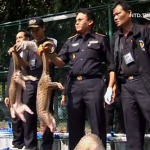Another tragic blow has been struck to the dwindling population of saiga antelopes.
Radio Free Europe/Radio Liberty reported that 60 saiga antelopes were discovered shot dead in northwestern Kazakhstan, with their horns removed. The tragic event illustrates that the gentle grazers remain under attack from wildlife traffickers capitalizing on the myths of animal horn cure-alls.
The saiga antelope (Saiga tatarica) has been listed as Critically Endangered by the IUCN since 2003. Saiga antelopes once prospered in the semi-desert and steppe regions of southeastern Europe and central Asia. This species can be found in Kazakhstan, Mongolia, the Russian Federation, Turkmenistan and Uzbekistan, but are now extinct in China, Moldova, Poland, and Ukraine.
Tragic story of the saiga antelope
The saiga antelope population was over one million as recently as 1993, but is now only about one-tenth of that number.
Saiga antelope horn is used as an an ingredient in traditional Chinese medicine; according to the IUCN, the saiga antelope was extinct in China by the 1960s.
Illegal hunting has put the put significant pressure on the species. The breakup of the former USSR has has led to less protection, while hunting of young males has led to a skewing of the sex ratio and adversely impacted the reproduction of the species.
Habitat destruction has also impacted the saiga antelope. The precious grazing lands and migration routes have been destroyed by agricultural abandonment, which has also allowed the encroachment of a plant which is inedible for saigas. Additionally, severe winters and steppe fires also challenge the saiga antelope.
Perhaps the most tragic blow was stuck by conservationists.
According to a 2003 article written in New Scientist by Fred Pearce, a plan to protect rhinos ended up decimating saiga populations.
In the early 1990s, groups such as WWF actively encouraged the saiga hunt, promoting its horn as an alternative to the horn of the endangered rhino.
The 1991 collapse of the Soviet Union created a lucrative black market, and the parallels to current rhino horn crisis are eerie.
Hunters working for wildlife trafficking syndicates “employed motorcycles and high-powered weapons” to gain the advantage on their helpless victims.
Traditional Chinese medicine practitioners claimed that saiga antelope horn was useful for treating the liver, convulsions, irritability, and “swollen eye”.
It has traditionally been used to drain Liver heat, calm the Liver, extinguish wind and control spasms and convulsions (for childhood convulsions and seizures, including during fevers, etc.), calm the Liver and anchor the yang (for dizziness, vertigo, irritability and restlessness, and splitting headaches), to clear the Liver and improve the vision (for headache, red and swollen eyes or photophobia), to drain heat and resolve fire toxicity (for high fever, delirium, manic behaviour, loss of consciousness etc.), and to clear damp-heat (for rhematic/arthritic disorders due to damp-heat).
Pearce writes, “in 1991 WWF began a campaign in Hong Kong to publicise it as an alternative” and the saiga population was cut in half between 1993 and 1998.
Meanwhile, stockpiles of saiga antelope horn began to accumulate from killings in Kazakhstan and Russia.
Although conservationists supported the substitution of saiga horn for rhino horn during the mid-eighties and early nineties, the dramatic crash of saiga antelope populations led to a change of opinion.
The Journal of Chinese Medicine also acknowledged the conservation disaster and says that practitioners are “actively discouraged” from using saiga antelope horn.
While this plan was well-intentioned, it had disastrous results, as by 2003 fewer than 30,000 individuals remained in Russia and Kazakhstan, which had previously had a population of over 1 million, largely due to rampant poaching for use in TCM.
However, the medicinal efficacy of animal horns remains dubious.
Image by Tiarescott (TerraNova, le désert de Gobi) via Wikimedia Commons





